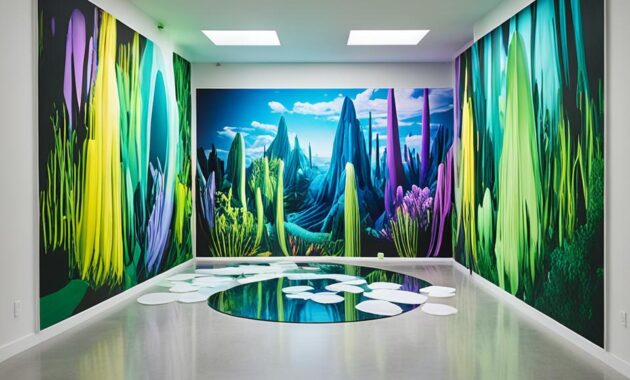Welcome to the captivating realm of fine arts, where creativity knows no bounds. This journey takes you through a diverse array of mediums, from the timeless elegance of painting and sculpture to the dynamic realms of photography and ceramics. Delve into the rich tapestry of art history, exploring the masterpieces that have shaped the cultural landscape and inspired generations of artists.
In this series, we invite you to unleash your own artistic potential and find inspiration in the ever-evolving world of fine arts. Discover how to harness the power of drawing, printmaking, and installation art to express your unique vision. Witness the blurring of boundaries between art and life through the mesmerizing realm of performance art.
Key Takeaways
- Explore a diverse range of fine art mediums, from painting and sculpture to photography and ceramics.
- Dive into the rich history of art, uncovering the masterpieces that have shaped the cultural landscape.
- Discover how to unleash your own artistic potential through various creative disciplines.
- Witness the dynamic interplay between art, life, and perspectives in the realms of installation and performance art.
- Embark on a journey of self-expression and creative exploration in the captivating world of fine arts.
Unveiling the Enchanting Realm of Fine Arts
Step into the captivating world of fine arts, where reality and imagination intertwine. This realm spans from classical masterpieces to modern innovations. It’s a journey through the history of fine arts, revealing the stories and techniques that have enthralled audiences for centuries.
Fine arts encompass a variety of disciplines, each with its distinct allure. They range from the timeless paintings in museums to the awe-inspiring sculptures in public spaces. This art form offers a gateway to a world rich in beauty, emotion, and intellectual stimulation.
The study of fine arts explores the evolution of artistic movements and the lives of famous artists. It also delves into the societal and cultural influences that have shaped art history. Whether you’re drawn to the Renaissance, Impressionism, or contemporary art, the fine arts offer a captivating journey of discovery.
Entering the enchanting world of fine arts means being captivated by visual expression. You’ll uncover the stories behind the brushstrokes, chisel marks, and light and shadow. This journey invites you to explore painting, sculpture, drawing, and more, unlocking your artistic potential.
Embrace the transformative power of fine arts to inspire, challenge, and broaden your understanding of the world. Step into this enchanting realm and start an artistic exploration. Here, the real and imagined blur, and human expression reaches its full potential.
“Art is not what you see, but what you make others see.” – Edgar Degas
A Journey Through Art History’s Greatest Masterpieces
Embark on a captivating journey through the annals of art history, where the greatest masterpieces come to life. Discover the breathtaking works of Renaissance geniuses, Michelangelo and Leonardo da Vinci, as they redefined the boundaries of painting and sculpture. Immerse yourself in the luminous world of Impressionism, where Claude Monet’s mesmerizing canvases captured the fleeting dance of light and color.
Exploring the Renaissance: Michelangelo and Leonardo da Vinci
The Renaissance era was a transformative period in the history of art, marked by the groundbreaking contributions of Michelangelo and Leonardo da Vinci. Michelangelo, the consummate Renaissance man, left an indelible mark on the world with his iconic works such as the Sistine Chapel ceiling and the sculpture of David. His masterful command of the human form and his ability to imbue his creations with profound emotional resonance continue to captivate and inspire art enthusiasts worldwide.
Alongside Michelangelo, Leonardo da Vinci stood as a true Renaissance polymath, excelling in a myriad of disciplines, from painting and sculpture to science and engineering. His renowned works, including the Mona Lisa and The Last Supper, showcase his unparalleled mastery of light, color, and perspective, ushering in a new era of artistic expression and technical innovation.
Impressionism: Monet’s Mastery of Light and Color
Shifting our focus to the 19th century, the Impressionist movement revolutionized the art world, with Claude Monet at the forefront of this transformative era. Monet’s captivating canvases, such as Water Lilies and Haystacks, celebrated the fleeting, ephemeral qualities of light and color, challenging traditional painting conventions. His innovative techniques, which involved capturing the immediate, sensory impressions of a scene, paved the way for a more vibrant and expressive approach to art, inspiring generations of artists to come.
The enduring legacies of Michelangelo, Leonardo da Vinci, and Claude Monet serve as beacons, guiding us through the captivating realm of art history and inspiring us to embrace the boundless possibilities of artistic expression.
Painting: Unleashing Your Creative Potential
Step into the vibrant realm of painting, where color and technique merge to unlock your creative potential. Painting encompasses a spectrum of styles, from the textured richness of oil painting to the fluidity of watercolors and the adaptability of acrylics. Each medium offers a distinct avenue to convey your artistic vision.
Mastering Techniques: Oil, Watercolor, and Acrylics
Delve into the varied techniques that shape painting. Oil painting invites you to build layers of color, imbuing your work with depth and luminosity. Watercolors, on the other hand, allow for spontaneity and transparency, capturing the fleeting nature of light and movement. Acrylics, with their blend of precision and vibrancy, offer a balance between control and lasting color.
Regardless of your chosen medium, a solid grasp of color theory, composition, and brushwork is essential. Experiment with different strokes, palette knife techniques, and blending methods to align with your artistic style.
- Explore the rich, textured world of oil painting
- Immerse yourself in the ethereal fluidity of watercolor
- Embrace the versatility and vibrancy of acrylic painting
- Develop your skills in color theory, composition, and brush techniques
“Painting is the practice of the mind.” – Paul Cézanne
As you navigate the world of painting, the essence of the journey lies in self-expression and discovering your unique artistic voice. Embrace the process, experiment with various art techniques, and allow your creativity to flourish. It is through painting that you fully express your creative potential.
Sculpture: Breathing Life into Stone and Clay
Sculpture, an art form that transforms lifeless materials into stunning works, has always fascinated artists and enthusiasts alike. Sculptors excel in bringing their creations to life, evoking emotions through form, texture, and light. This art form has a profound ability to tell stories.
The variety of sculpting mediums is astounding. Air-dry clay is a favorite among beginners for its ease and cleanliness. Ceramic clay, though more challenging, allows for detailed, lasting sculptures. Sculptors also explore innovative mediums like fabric, epoxy clay, and mixed media, each offering unique challenges and creative possibilities.
Antonio Canova, an Italian sculptor, exemplifies sculpture’s transformative power. Starting at 11, he apprenticed and refined his skills. His neoclassical masterpieces, including marble sculptures, have adorned prestigious institutions and the homes of influential patrons, captivating with their realism and emotional depth.
Canova’s work inspired many, including Auguste Rodin. Rodin’s innovative works, like “The Age of Bronze” and “Eve,” challenged traditional sculpture by embracing human imperfections. Artists like Bourdelle, Wlérick, and Lehmbruck further expanded sculpture’s boundaries, each with their distinct styles and interpretations of humanity.
| Sculpting Medium | Key Characteristics |
|---|---|
| Air-Dry Clay | User-friendly, mess-free, and suitable for beginners |
| Ceramic Clay | Requires more precautions but allows for intricate, permanent sculptures |
| Fabric | Experiencing a resurgence as a medium for creating sculptures |
| Epoxy Clay | Cures through a chemical reaction, offering strength and durability |
| Mixed Media | Offers flexibility and the ability to incorporate various found or altered objects |
As sculpture evolves, artists continually explore new mediums and techniques to express their visions. Whether through marble’s timeless beauty or clay’s expressive qualities, sculpture remains a captivating realm. It invites artists and enthusiasts to witness the transformation of the ordinary into the extraordinary.
Drawing: Capturing the World with Pencil and Charcoal
Delve into the timeless realm of drawing, where pencils and charcoal serve as mediums to encapsulate the world’s essence. This fundamental skill enables artists to convey their distinctive viewpoints, ranging from the meticulous realism of the Old Masters to the avant-garde expressions of contemporary artists.
Mastering Perspective and Proportions
The cornerstone of drawing is the grasp of perspective and proportions. Artists who excel in creating depth and dimension on a flat surface can bring their imaginative visions to life with remarkable clarity. Through diligent observation and the refinement of techniques such as linear perspective and human anatomy, budding artists can hone their skills to produce captivating drawings that engage the viewer.
Exploring Different Styles: Realism, Abstraction, and Beyond
Within drawing, a diverse array of styles exists, each with its distinct approach to depicting the world. Realism demands artists to meticulously replicate their subjects’ details, whereas abstraction allows them to delve into the expressive capabilities of line, shape, and color. Modern artists have further expanded drawing’s horizons, experimenting with mixed media, conceptual themes, and innovative methods.
“Drawing is the honesty of the art. There is no possibility of cheating. It is either good or bad.”
– Salvador Dalí
For both seasoned artists and novices, drawing opens a realm of possibilities for capturing the world’s beauty and intricacy. By adhering to the fundamental principles and venturing into the diverse styles of this enduring medium, one can unlock their creative potential and embark on a visual expression journey.
Photography: Freezing Moments in Time
The art of photography is a captivating journey, where the click of a shutter can immortalize the world around us. This enchanting realm requires a deep understanding of composition and lighting to shape the art of photography.
Exploring Composition and Lighting
Composition is the cornerstone of photographers’ visual creations. By mastering balance, framing, and the rule of thirds, photographers can craft images that engage the viewer and convey their artistic vision.
Lighting plays a pivotal role in photography. By skillfully manipulating natural and artificial light, photographers can sculpt shadows, highlight textures, and evoke emotions. This elevates their photographs to the level of fine art.
- Explore the rule of thirds to create dynamic and visually appealing compositions.
- Experiment with different lighting techniques, such as side lighting, backlighting, and front lighting, to add depth and drama to your photographs.
- Harness the power of natural light, whether it’s the golden hour or the soft, diffused glow of an overcast day, to infuse your photographs with a captivating ambiance.
As you delve deeper into the world of photography, you’ll realize the camera is not just a tool but a brush. The world becomes your canvas. Embrace the art of fine art photography, where the lens extends your vision. Every shutter click freezes a moment in time, leaving an indelible mark on the hearts and minds of your audience.
“The camera is an instrument that teaches people how to see without a camera.” – Dorothea Lange
Ceramics: Molding Clay into Artistic Expressions
Explore the captivating realm of ceramics, where clay metamorphoses into intricate art. Delve into the diverse techniques of pottery, sculpting, and tile-making. Each method provides a distinct avenue for artistic expression. Artists utilize the malleable nature of clay to craft both functional and sculptural pieces, showcasing its versatility.
Pottery: Crafting Function and Beauty
The tradition of pottery is both timeless and enduring. Skilled artisans mold clay into objects that serve practical purposes yet possess artistic merit. From the delicate curves of teacups to the robustness of vases, each piece reflects the potter’s meticulous craftsmanship and creative vision. Techniques such as hand-building, wheel-throwing, and slip-casting yield distinct textures and forms, engaging the senses.
Sculptural Clay: Breathe Life into the Inanimate
Clay sculpture enables artists to infuse life into the lifeless, turning clay into captivating three-dimensional forms. Whether crafting detailed figurines or grand abstract sculptures, clay artists imbue their creations with emotion and distinct personalities. Processes like hand-building, coiling, and slab-building, along with various firing techniques, bring these clay sculptures to vibrant life.
Tile-Making: Decorative Surfaces and Architectural Accents
Tile-making is a versatile ceramic art form that transforms ordinary surfaces into extraordinary works of art. From the intricate patterns on floor and wall tiles to architectural embellishments, the possibilities are vast. Techniques such as slab-building, press-molding, and hand-painting allow ceramic artists to create detailed designs that elevate any space.
| Ceramic Technique | Description | Examples |
|---|---|---|
| Pottery | The art of shaping and molding clay into functional objects | Vases, bowls, cups, plates |
| Sculpture | The creation of three-dimensional forms using clay | Figurines, abstract sculptures, ceramic installations |
| Tile-making | The production of decorative and functional tiles for surfaces | Floor tiles, wall tiles, architectural accents |
Step into the enchanting world of ceramics, where clay is transformed into extraordinary art. Whether you’re captivated by the timeless beauty of pottery, the expressive nature of clay sculpture, or the decorative charm of tile-making, this ancient medium offers boundless opportunities for artistic exploration and expression.
Printmaking: Unleashing the Power of the Press
Step into the captivating realm of printmaking, where the press transforms into a canvas for artistic expression. Discover the diverse techniques that have enthralled artists for centuries. From the vivid colors of screen printing to the detailed precision of lithography and the bold strokes of relief printing, each method offers a distinct artistic voice.
The art of printmaking is a complex blend of creativity, where each technique plays a unique role. Etching enables artists to inscribe their visions onto metal plates, resulting in intricate designs that invite viewers to delve into every detail. Conversely, relief printing allows artists to carve their concepts into woodblocks, offering a tactile experience that celebrates the hand-crafted essence of art.
Whether you’re captivated by the spontaneity of screen printing or the precision of lithography, printmaking presents a vast expanse of creative possibilities. Printmakers adeptly utilize these processes, transforming simple materials into captivating artworks that engage the senses and spark the imagination.
“Printmaking is the art of the multiple, the art of the edition, the art of the collaboration. It’s a way of thinking about making art that is not just about the individual artist alone in the studio.” – Kiki Smith, renowned American artist
Prepare to be astonished as you explore the enchanting domain of printmaking. Here, the press’s power unleashes a symphony of artistic expression. Embrace the tactile allure of these enduring techniques and unlock your creative potential in unprecedented ways.
Installation Art: Transforming Spaces and Perspectives

Embark on a journey through the realm of installation art, where artists redefine traditional art forms. These innovative works transform spaces into immersive experiences, dissolving the distinction between the audience and the artwork.
At the core of installation art is site-specific art, where the environment is a crucial element of the artwork. Artists meticulously design their installations to resonate with the unique qualities of a space, merging the artwork with its surroundings seamlessly.
Installation art transcends mere spatial alteration; it encourages audience participation, making them an essential part of the artistic experience. These interactive art pieces prompt visitors to engage with the work, fostering a profound connection with the artist’s vision.
The realm of installation art encompasses a broad spectrum, from expansive, room-encompassing installations to detailed, site-specific interventions. Artists utilize a diverse array of materials, including traditional mediums like paint and sculpture, alongside unconventional elements such as light, sound, and living organisms, to create their immersive artworks.
Prepare to have your perceptions challenged and your senses heightened as you explore the captivating world of installation art. Discover how these transformative artworks redefine our understanding of art, space, and our role as participants in the creative process.
“Art is not what you see, but what you make others see.” – Edgar Degas
Performance Art: Blurring the Lines Between Art and Life
In the realm of fine arts, performance art emerges as a groundbreaking and intellectually stimulating medium. It diverges from traditional art forms, challenging our understanding of artistic expression by blurring the lines between art and life.
Performance art employs the artist’s body and actions as the medium, transcending conventional artistic boundaries. This genre compels the audience to ponder the essence of art. It encompasses a spectrum from conceptual art to avant-garde performances, reshaping our perception and interaction with creative endeavors.
This art form’s essence lies in its ephemerality and the immediacy of the live experience. Unlike static artworks, performance art’s existence is confined to the present, leaving behind only remnants and memories for contemplation by the audience.
“Performance art is about living in the present, about using the body as a medium, about creating experiences that challenge and provoke the viewer.” – Marina Abramović, renowned performance artist
The transient nature of performance art has spawned a plethora of styles, each with distinct approaches and messages. From the Guerrilla Girls’ political statements to Marina Abramović’s introspective works, this medium has become a potent vehicle for artists to convey their visions and interact with their audience innovatively.
As the distinction between art and life erodes, performance art exemplifies the resilience of human creativity. It encompasses a spectrum of experiences, from participatory engagements to conceptual explorations, urging us to reevaluate our roles as observers and co-creators within the artistic realm.
Embracing the World of Fine Arts
The vast and enchanting realm of fine arts beckons us to explore its boundless creativity. It invites those who are aspiring artists, passionate art enthusiasts, or individuals seeking a fulfilling career. The world of fine arts offers endless opportunities for personal growth and cultural enrichment. Discover the joy of art appreciation, where you can immerse yourself in the beauty and meaning of timeless masterpieces.
Embracing the transformative power of art education can open new doors, nurturing your skills and igniting your artistic expression. From mastering the techniques of painting, sculpture, and drawing, to delving into the rich tapestry of art history, the fine arts provide a pathway to self-discovery and a deeper understanding of the human experience.
The fine arts also present a diverse array of career paths, allowing you to turn your passion into a fulfilling profession. Whether you aspire to be a renowned artist, a curator in a prestigious museum, or a creative director in the world of design, the opportunities within the fine arts are boundless. Embark on a journey of self-expression, cultural enrichment, and a lifelong love affair with the endless possibilities that the fine arts have to offer.





